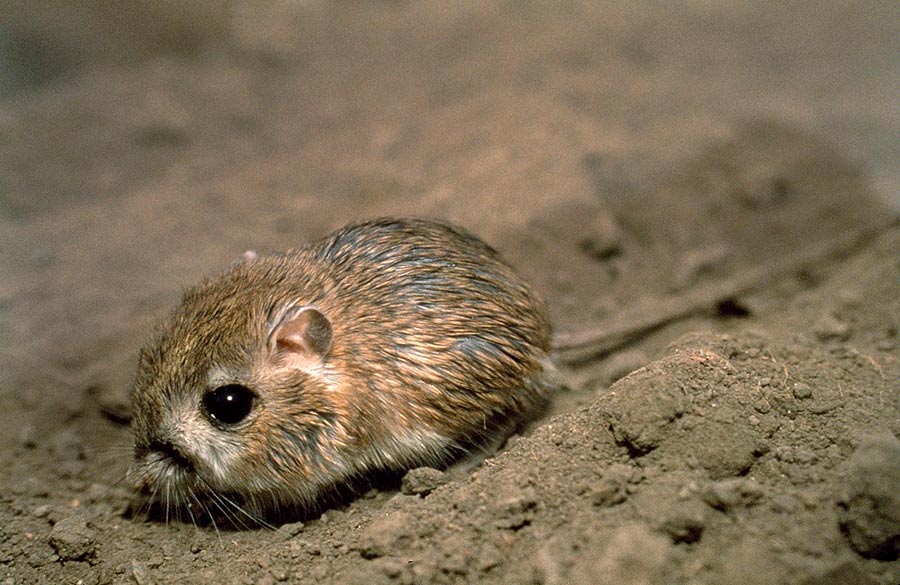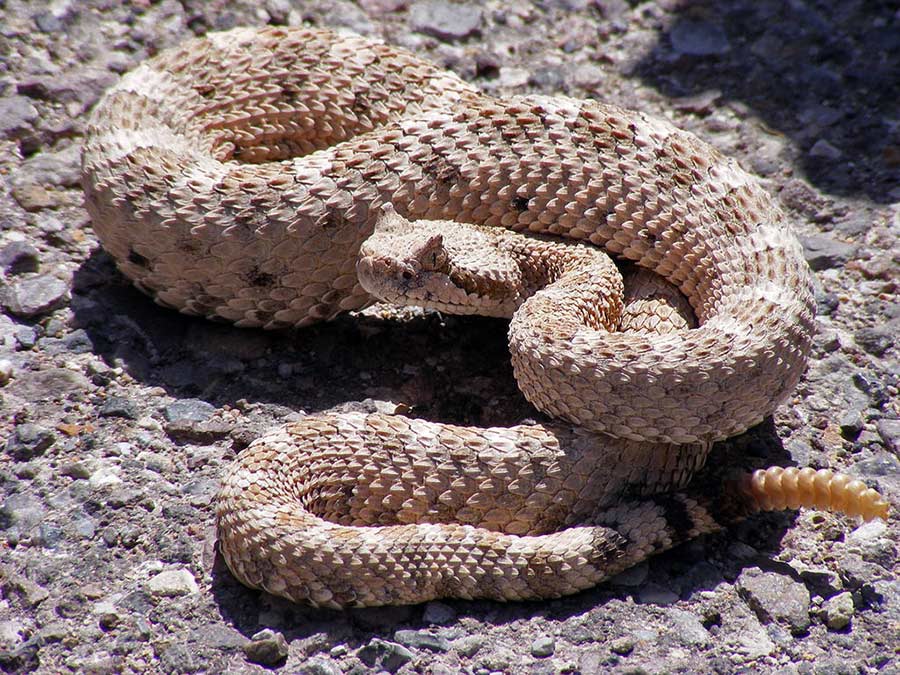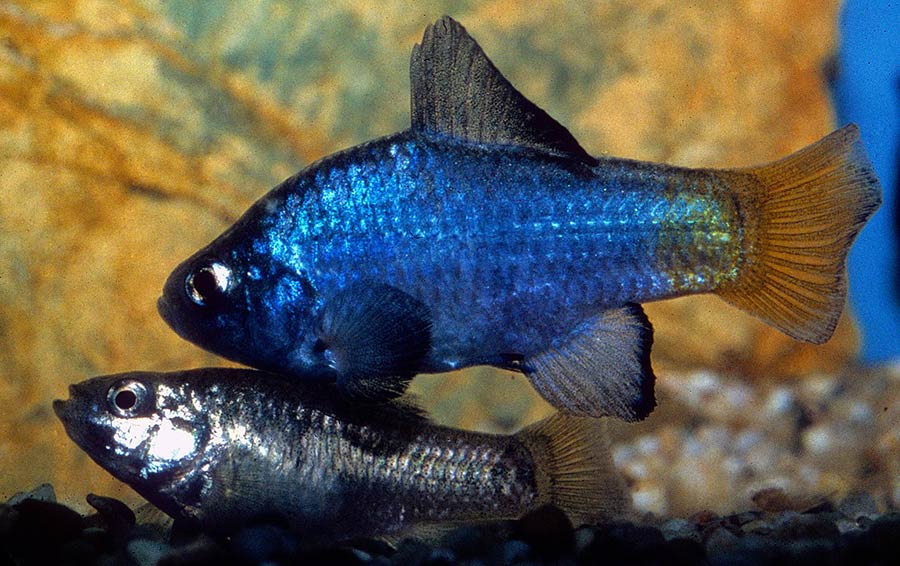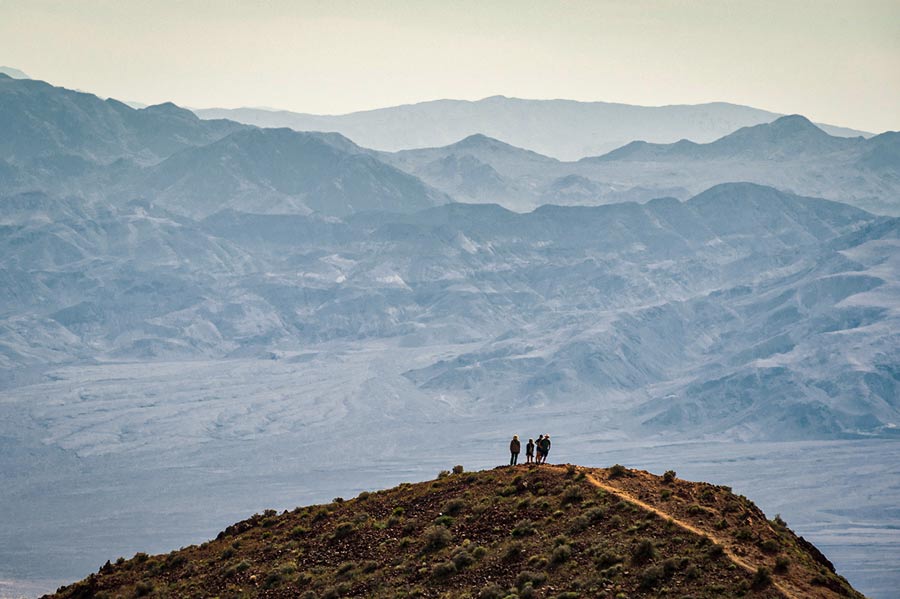How Do Animals Survive In Death Valley
Surviving Summer in Death Valley

A coyote crosses a road near Furnace Creek. NPS Photo
The extremes of summer in Death Valley pose the ultimate test of survival for wild animals. Animals must have special adaptations of both their bodies and their habits to thrive in the severe climate. The kangaroo rat, sidewinder and pupfish are among the most successful, simply each in their ain unique fashion.

Kangaroo Rat
By California Section of Water Resources - California Section of Water Resources, Public Domain, https://commons.wikimedia.org/w/index.php?curid=56602834
Kangaroo Rats
Kangaroo rats are consummately adapted to the dryness and rut of Death Valley's summer. In this identify famous for its lack of water, kangaroo rats can live their entire lives without drinking a drop of liquid. All of the water they demand to survive can be metabolized within their bodies from starch and fats in the dry seeds they eat. They are as well masters at conserving wet; their kidneys have the ability to concentrate urine 4 to 5 times that of humans.
Kangaroo rats avoid the intense heat of the day, as nearly desert animals do, by restricting their activeness to the night. Days are spent deep underground in burrows that are both cooler and college in humidity than outside. The water vapor contained in the humid air is reclaimed by special membranes in their nasal passages, and is likewise absorbed by the food stored within the den. They may even plug the burrow's archway with dirt to keep out heat and intruders.

Sidewinder, Crotalus cerastes, Mesquite Springs Campground, Expiry Valley National Park, CA.
by Tigerhawkvok (talk · contribs), CC BY-SA three.0 , via Wikimedia Commons
Sidewinders
The sidewinder may be ane intruder the kangaroo rat is trying to go along out of its den. This small-scale rattlesnake is best known for its odd looping motion as it travels, but it, too, is well adapted to the extremes of Death Valley'due south climate. Like the kangaroo rat, the sidewinder does not need to potable water.
All the moisture information technology requires comes from the juicy animals information technology eats. The sidewinder is also nocturnal and spends the hot days in underground dens. Rather than earthworks its own burrow, information technology simply moves into one previously occupied by the unlucky rodent information technology ate for dinner. Like all reptiles, the sidewinder is cold-blooded (ectothermic). Warm-blooded (endothermlc) animals such every bit kangaroo rats and humans metabolize torso heat from food, but ectothermic animals must blot rut from their surroundings. Deserts accept lots of rut, but petty food, so ectothermic animals such as reptiles brand first-class desert dwellers.

Desert Pupfish - Cyprinodon macularius tactile stimulation in courting
By P.5. Loiselle - Correspondence/personal work of P.Five. Loiselle, CC By-SA 3.0, https://commons.wikimedia.org/w/alphabetize.php?curid=29838181
Desert Pupfish
The tiny pupfish found in Common salt Creek on Death Valley's arid flooring are also ectothermic, all the same they cannot escape the loftier temperatures of solar-heated pools. Pupfish are amid the most heat tolerant of all fishes. They have been known to survive in water temperatures of 112 degrees F.
Some pupfish species in the Expiry Valley area actually live in hot springs. The pupfish of Salt Creek are and so adjusted to warm water, they must burrow into the mud and get dormant when the shallow stream becomes common cold in the winter. Another obstacle these fish face is high salinity. Pupfish tin survive in water 2 to 3 times saltier than sea water. When Salt Creek evaporates in the summer, the dissolved salts get even more concentrated. Fish living in fresh water tin absorb water through their body by osmosis, simply pupfish and other common salt water fish must drink to get their necessary water. Excess salts are and so excreted through their kidneys and gills.

People at Dante's View
NPS Photo
Humans
Man beings must also drink h2o, simply our bodies can just procedure fresh water. People perspire, allowing the evaporating water to pull the heat away from our bodies, but so we must supplant the lost h2o. Our activity can also exist timed to avoid the hottest function of the twenty-four hour period. We may share some habits with desert wildlife to crush the heat and dryness, simply our real success comes from our ability to change our environment to come across our needs.
Timbisha Shoshone, the Native American people who take lived in Death Valley for centuries, did the virtually logical thing when summer arrived -- they left for higher and cooler country. In the early on history of the valley, almost anybody else followed their example. Just a few hardy souls stayed backside to face up the intense heat of summer. Miners working the Keane Wonder Mine in 1908 complained that even eating became difficult; the silverware was too hot to handle. Original caretakers of the Greenland Ranch at Furnace Creek slept in the irrigation ditches and devised a water-wheel powered fan to cool themselves. Today, with electric air conditioners and evaporative coolers, we homo beings tin can discover shelter from Death Valley'southward oestrus.
Technology has brought an influx of summertime visitors never before known to this expanse. If you visit, keep in listen that only an artificial shelter allows you to exist here in relative comfort. You are not equally physically adapted to survive in Death Valley'south summer every bit its wildlife residents.
Related DesertUSA Pages
- How to Turn Your Smartphone into a Survival Tool
- 26 Tips for Surviving in the Desert
- Decease by GPS
- seven Smartphone Apps to Meliorate Your Camping Experience
- Maps Parks and More
- Desert Survival Skills
- How to Keep Water ice Cold in the Desert
- Desert Rocks, Minerals & Geology Index
- Preparing an Emergency Survival Kit
- Become the Best Hotel and Motel Rates
Share this page on Facebook:
DesertUSA Newsletter -- We transport articles on hiking, camping and places to explore, too every bit animals, wildflower reports, plant information and much more. Sign up below or read more virtually the DesertUSA newsletter hither. (It's Gratis.)
The Desert Environment
The Northward American Deserts
Desert Geological Terms

Source: https://www.desertusa.com/desert-california/dvheat.html
Posted by: louisterew1970.blogspot.com


0 Response to "How Do Animals Survive In Death Valley"
Post a Comment